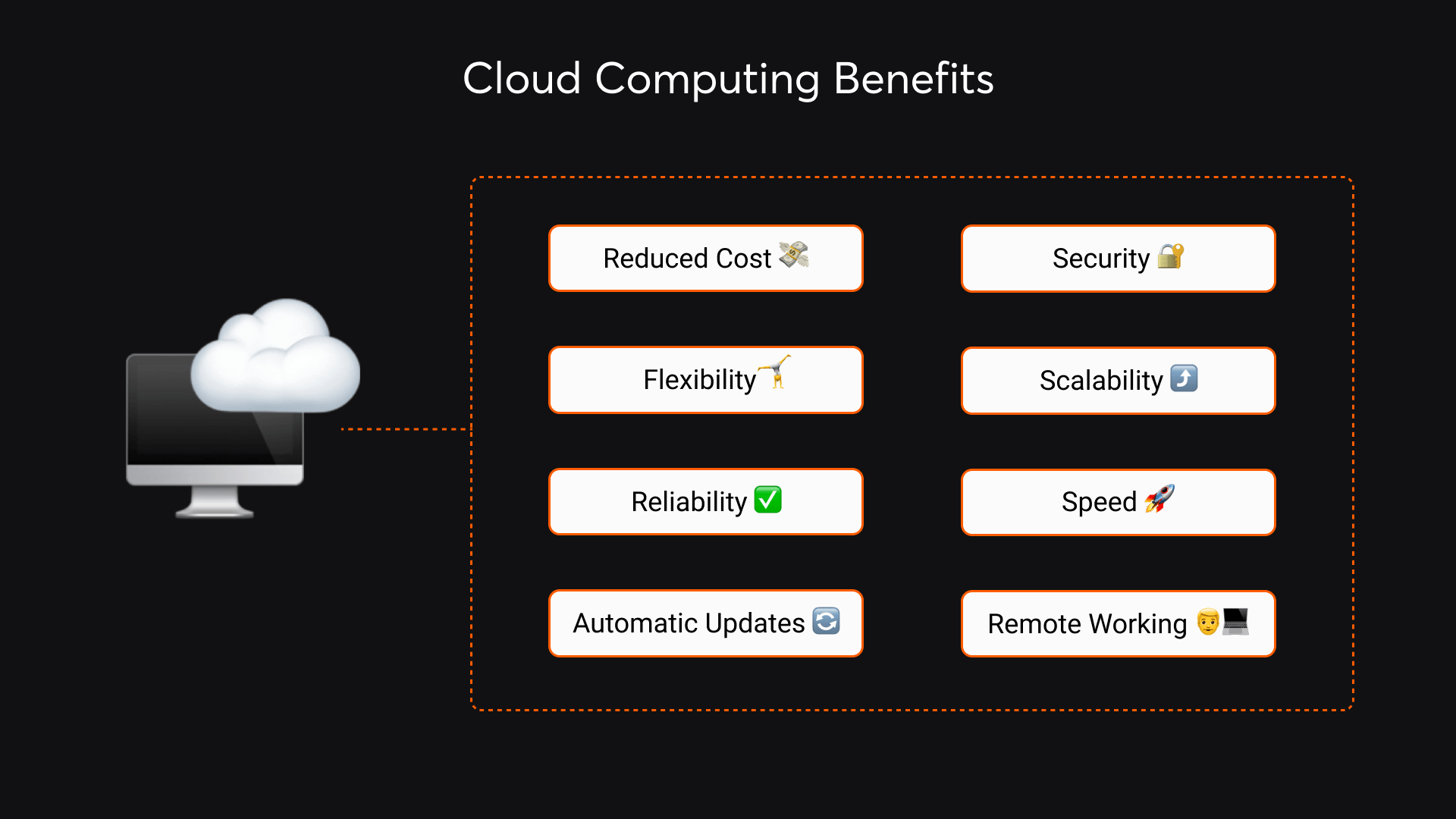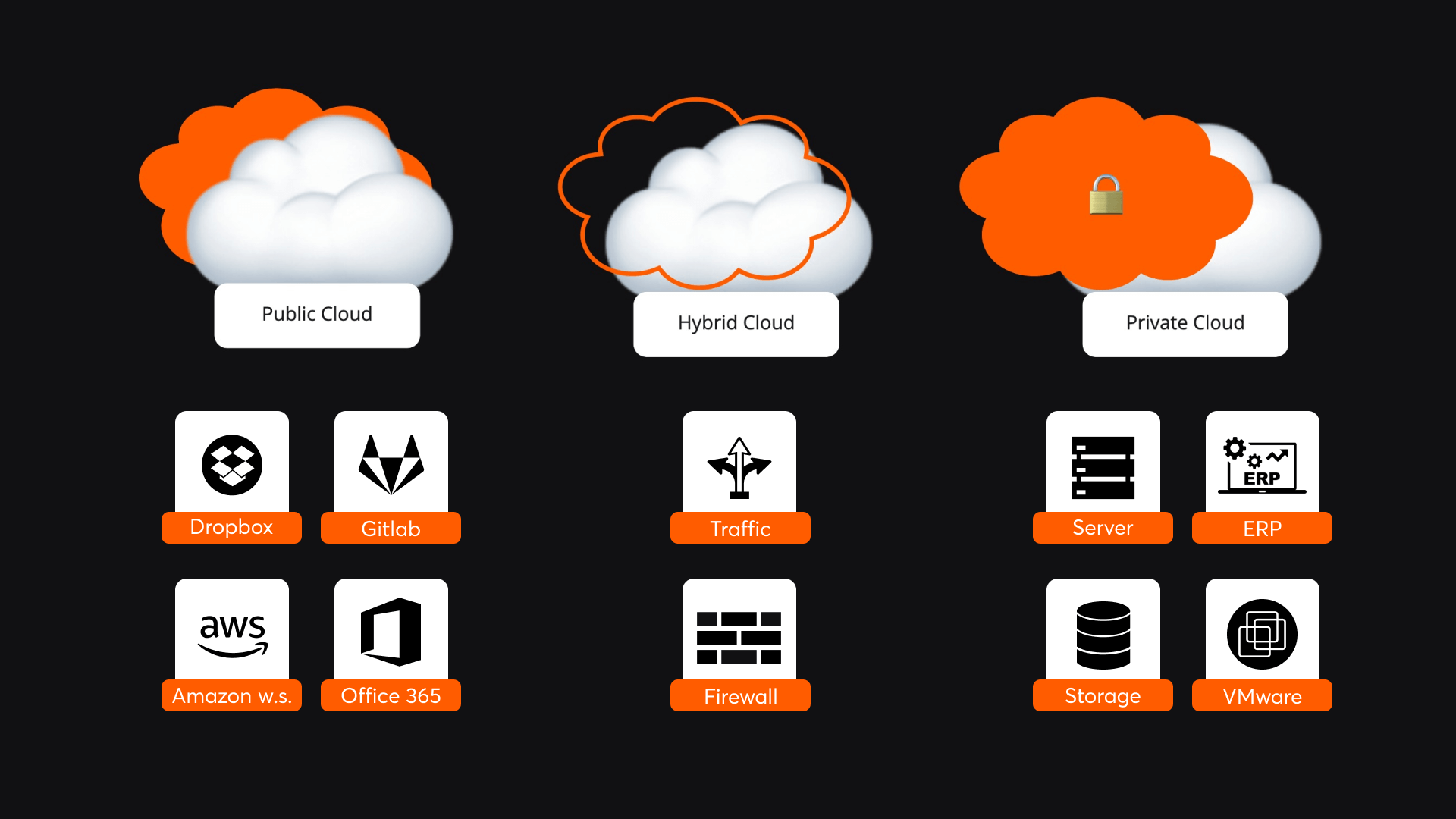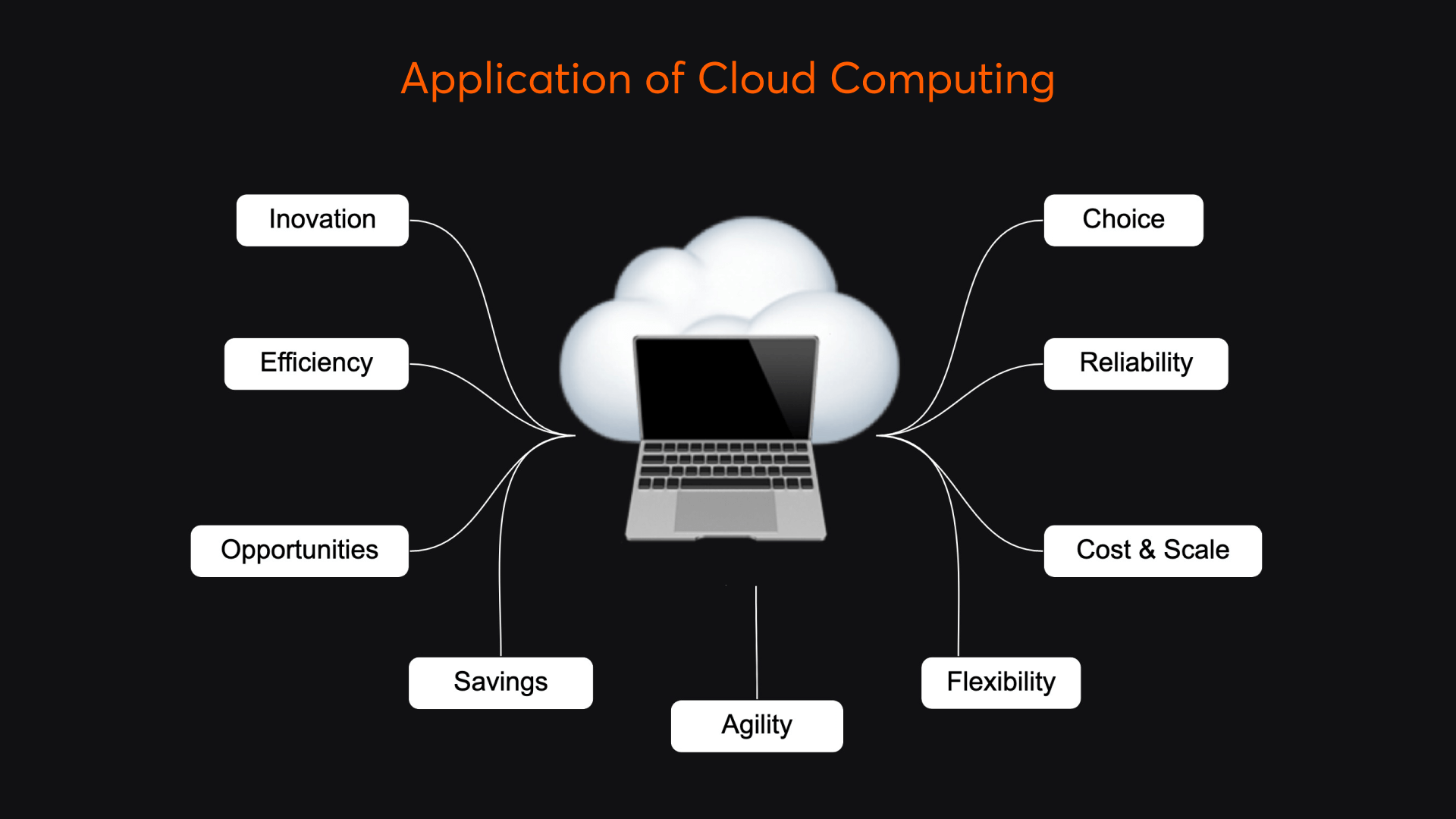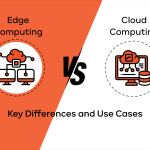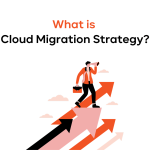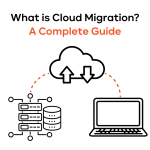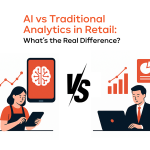It was back in 2014 when the majority of workloads were made in the cloud for the first time.
Now, in 2021, this domain generates more than 300 billion US dollars in revenue annually. Cloud computing examples are numerous, including digital giants like Google Cloud, Salesforce, Creatio, and Slack.
So, what is the definition of cloud computing, and what is the service all about?
To put it simply, cloud computing manages, processes, and stores your data, not on the premises, but on the web. For this storage, an interconnected network of servers is used.
The technology applies to everything from sharing corporate-level banking data to storing photos of your cat on Google Drive. There are even more use cases you should know about.
In this article, we tell you more, namely:
Let’s get straight to the point!
What is Cloud Computing?: Key Things You Should Know
Companies like Dell Technologies are among the most successful cloud computing examples.
Statista reports that Dell made 2.47 billion US dollars from cloud sales in just the first quarter of 2021.

Companies using cloud computing are willingly paying big money to cloud providers for the benefits they receive. Since the demand drives the proposition, new cloud computing tools and technologies are rising with unprecedented speed.
Below, we briefly describe the main types and uses of cloud computing.
What is Cloud Computing in Simple Terms?
Cloud computing is storing, managing, and using data on the internet instead of doing the same on a physical computer.
One of the simplest examples of cloud computing applications is saving data in Google Docs. This allows you to create and save a document remotely instead of storing it as an MS Word document on your PC.
How does cloud computing work?
With cloud computing, you get access to a network of remote servers. You use this access for different operations like running software, storing information, or transferring data. Earlier, you could only do this via local storage or a physical PC.
As technology has evolved, cloud computing examples have varied. Today, you may encounter public, private, or hybrid cloud services.
- Public cloud is delivered by a third-party provider. You get free or paid access to the cloud and share its services with other people.
- Private cloud consists of cloud computing products that are created specifically for your company.
- Hybrid cloud allows you to run a part of your workload on the premises, and when it gets too intense, you transfer a part of operations to the cloud.

What are the Types of Cloud Computing Services?
This feature allows IT vendors to explore new areas for application. Today, all existing cloud computing examples are split into three groups.
1. Software-as-a-Service – lets users utilize programs that are not stored on their computers.
The examples of cloud computing in the domain of SaaS are:
- Gmail
- Rackspace
- Grammarly
- Google Translate
Altogether, the SaaS sector is projected to generate 172 billion USD in 2022, as Statista reports.
2. Platform-as-a-Service – platform is something that unites the engine and a customer interface.
PaaS providers offer:
- Virtual servers
- Databases
- Operation environments
Customers use these to set and run their software. AWS Elastic Beanstalk, Magento Commerce Cloud, and Apache Stratos are cloud computing examples in the domain of PaaS.
Interesting fact: According to statistics, in 2022, the PaaS market will reach 101 billion USD.
3. Infrastructure-as-a-Service – provides components that make the work of an IT office possible.
This operation of cloud computing services includes:
- Physical servers
- Networks, routers
- Device storage, etc.
Together, they create an environment to set platforms and run the software. The IaaS sector now generates 122 billion US dollars a year, according to statistics.
SaaS, PaaS, and IaaS are the three main cloud computing service models. There is another model, gaining popularity, called FaaS or Function-as-a-Service. This model allows developers to split the functionality of their product and work on each feature separately.
To benefit from any of the cloud-based computing services, a company needs a proficient cloud migration provider. Today, numerous companies like IT-Magic help businesses scale up, improve security, and maintain high uptime when using cloud infrastructure like AWS.

Want to learn how your business can benefit from cloud computing systems?
IT-Magic will give you a consultation on cloud services examples and how to use the advantages of cloud services in your business niche, calculate the possible cost and time of the migration, and explain how to mitigate the security risks.
Contact us for a free consultation
Why Does Your Business Need Cloud Computing Technology?
Today, the benefits of cloud computing are available to everyone, from the beginning entrepreneur to enterprises. They include open-source software, experience sharing, heightened safety, less downtime, and much more.
But are there only advantages you can receive from cloud computing?
Actually, it varies. Despite the obvious merits, cloud services examples can become a challenge if utilized incorrectly. According to statistics, 86% of companies may face issues with cloud computing platforms, namely:
- Difficulties with controlling cloud costs
- Security issues
- Issues when managing data in multi-cloud
- Privacy concerns
- Dependence on internet connection
Therefore, a wise decision is to search for an experienced IT company like IT-Magic that helps employ cloud computing services in a way intended to make the most out of them. This is a street-smart option to make the best of the benefits of cloud computing, namely:
- Reduced costs
- Simpler access to expertise
- Security and tech support
- Better time-to-market
- Scalability
- Accessibility
What Are Some Examples of Cloud Computing?
Kimberly Mlitz, a research expert, predicts that companies worldwide will continue to shift to the cloud. Accordingly, the range of cloud services will only increase.
We cannot foresee what cloud innovations we will see in the near future. However, the cloud computing examples today are impressive. They satisfy the needs of millions of users and generate billions in income.
Here is a shortlist of the leading cloud computing examples.
1. Dropbox
Dropbox is a file sharing and storage service. The service gives you space and the opportunity to work on a pack of documents with other team members remotely. Beyond documents, Dropbox has partnered with Vimeo in order to share team videos too.
Today, Dropbox has 15.48 million paying users. This is 9 million more compared to 2015.
2. DigitalOcean
The company started as a wireless technology maker and creator of the first smartphone in the world, Seahorse. Today, DigitalOcean is one of the world’s first IaaS producers. They provide users with virtual machines, apps, databases, virtual private cloud, cloud firewalls, and other virtual infrastructure elements needed for uninterrupted business operations.
3. Salesforce
This year, 2021, Salesforce generated 5.4 billion dollars from their cloud service. This is one of the leading world cloud computing examples in the domain of SaaS. In addition, it offers a great CRM tool that facilitates the work of marketing teams around the world. Better lead management, marketing campaigns, profound statistics – these are just a few of the benefits you get with Salesforce.
4. Creatio
Creatio is a CRM provider that offers low-code solutions. Creation’s most popular services are:
- Sales Creatio – sales automation software
- Marketing Creatio – marketing automation services
- Service Creatio – help-desk software
In 2021, Creatio announced low- / no-code solutions as their main focus. They want to merge experiences for operational and IT professionals and, in this way, beat competitors like Salesforce and Microsoft Power BI.
This means open-source cloud solutions which require no technical background to use them. This approach is promising and innovative, which makes Creatio an exciting item on our list of cloud computing examples.
5. Slack
Slack is a simple but brilliant tool for communication and document sharing. Its primary aim is group chatting. You can group conversations by individuals, topics, teams, and projects. Eventually, the company added a video-conferencing feature and file sharing. Today, they offer numerous third-party integrations.
Why did we choose Slack as one of the notable examples of cloud computing?
Slack impresses with its simplicity, but manages to attract government-level partners, like NASA.
6. Google Cloud
For those who asked for cloud computing examples in the domain of IaaS, Google Cloud is the best answer. The services provided by Google Cloud are various, including SaaS and PaaS solutions.
Google gives you everything: cloud storage, development tools, access to machine learning and database management, and much more.
In simpler terms, if you need to build an application, you may rely entirely on Google Cloud for the resources. As well, if you need to store data securely, you have Google Drive.
There is no need to mention that Google Cloud is one of the leading examples of cloud computing in the industry. According to statistics, 23% of businesses worldwide use Google Cloud solutions. In addition, the company’s revenue in 2020 was 13 billion US 2020.
7. Microsoft 365
Microsoft 365 is the new name for the Office 365 suite. Microsoft rebranded in April 2020, but promised to keep the value of their old products.
Microsoft 365 gives cloud access to software products like Word, Excel, PowerPoint, and Publisher. Additionally, the service allows multiple users to work on one document and offers cloud storage. As a result, Microsoft 365 is one of the classic cloud computing examples.
Today, Statista mentions that 11% of companies using cloud computing rely on Microsoft 365 as a vendor.
8. AWS
Amazon Web Services is one of the leading cloud computing examples in the world. This is a PaaS company providing developers with resources for coding. You can run code or check back-end functionality for your website or application, all while totally relying on Amazon’s tools.
After its launch in 2006, AWS has been growing steadily. Today, the share of AWS in cloud infrastructure services is 33%. In 2020 the segment’s revenue was 45 billion USD, according to statistics.
9. Adobe Creative Cloud
In the 30 years of Adobe’s history, the company’s products like Photoshop and Illustrator have become synonymous with image editing.
In 2012, the company made a big move. Instead of offering users the ability to purchase and install software packages, Adobe released Creative Cloud. Thus, they moved to the SaaS model. This means that now any user can access any of their products on the cloud for a subscription.
How does this differ from a previous model?
Before, you had to buy new software for updates. Now, your software updates automatically.
In the beginning, it wasn’t one of the successful cloud computing examples. When Adobe announced the shift to the cloud, about 50,000 users signed a petition on Change.org to stop the migration to the cloud.
Adobe had to prove that during the transition, the customers won’t lose the value of services. And they did it. In 2020, the Creative Cloud package reached around 8 billion USD in net sales.
10. Microsoft Power BI
As a big name in the industry, Microsoft Power BI is also one of the prominent cloud computing examples. The platform promises to help businesses with data management.
As a business owner, a person may get lost working with significant amounts of data. Microsoft Power BI offers tools to easily collect, store, extract, and analyze the necessary information.
Microsoft’s cloud services have been steadily growing in demand since 2014. In 2021, according to statistics, the cloud segment has become the most significant revenue maker for the company.
All these 10 examples of cloud computing have one feature in common: they grow and develop. In general, cloud-based computing services generated 300 billion USD in 2020, according to the latest reporting.
If you are interested in how cloud computing may change the face of your business, you should find a vendor specializing in migration to the cloud.
Cloud Computing Examples: Application in Distinct Industries
The uses of cloud computing are vast. Practically speaking, there is a solution for every business niche.
Here are several examples of cloud computing by industry.
1. Social Networking
Social networking is perhaps among the best in terms of the application of cloud computing examples. The most popular social network, Facebook, is cloud-based. Facebook allows billions of users to upload heavyweight videos and photos, chat, and make posts in real-time. This would be almost impossible if everyone had to make changes locally and synchronize with the rest of the world.
Within the cloud, the data is in sync and smoothly distributed between billions of devices in seconds.
2. Communication Media
You may find different interesting cloud computing examples with communication media. For example, Skype, WhatsApp, CloudTalk, Bitrix, GoToConnect, Zoom, and Fuze are all cloud-based services. This paradigm allows these apps to constantly update without causing trouble for their customers, offer services to teams of any size, and keep data secure.
3. Healthcare
Cloud health records have long since become a practical tool in medical establishments. This technology facilitates medical care when a patient has to travel a lot and is one of the life-saving cloud computing examples in an emergency.
Examples of cloud computing software in medicine are IBM’s Collaborative Care Solution and Microsoft’s Azure. The latter provides hack-proof tools for storing sensitive information.
4. Education
Cloud computing applications allow students and teachers worldwide to exchange study materials.This approach allows students access to cutting-edge study materials from a simple smartphone.
Cloud computing enables online classes, open libraries, meetings and seminars, and much more. Some of the great cloud computing examples in education are Ratatype and SlideRocket.
5. Government Services
The United States federal government was the biggest user of cloud computing back in 2013. Today, nearly all government organizations, including the space agency NASA, have shifted to the cloud.
The federal government is like a huge corporation with millions of workers. It is important they have all the access to the resources they need and that the results of their work are being synchronized in real time.
6. Marketing
The implementation of cloud computing examples in marketing has many different faces. This helps to cut spending on infrastructure, ensures the safety of data, and enables big data processing.
Marketing agencies worldwide are racing toward the implementation of AI-based analytics. The latter is not possible without clouds.
In marketing, cloud computing applications are used for everything: email marketing, lead management, order management, social media, SEO, etc.
The brightest cloud computing examples in marketing are HubSpot, Salesforce, AgileOne, and Microsoft Dynamics.
7. Streaming Platforms
How do you think Netflix has managed to grow from a US-based DVD-rental service into the first-ever global TV network?
This growth happened thanks to the migration to AWS.
Today, Netflix provides streaming services in almost every country of the world. They have 207.6 million paying subscribers. As Netflix reports, the company earns 25 billion US dollars a year, and they continue to grow.
Thanks to the migration to AWS, Netflix has become one of the most successful cloud computing examples in the world.
Netflix originally decided to migrate when a crash in their on-the-premise data center stopped the whole business for three days.
By that time, the number of their users had grown rapidly and they faced the need to scale up correspondingly. So, they had to either build a world-class data center or migrate. Netflix decided to proceed with the latter and has not failed since.
8. Banking & Finance
Statista forecasts that banking institutions worldwide are planning to increase reliance on cloud technologies by 2023.
Like other institutions, banks have to be adaptive, secure, and innovative. For this, they need the benefits of cloud computing, like:
- Synchronization
- Resilience
- Better IT security
- Scalability
- Innovation
As of 2021, 54% of financial institutions in the USA rely on cloud computing services.
Cloud Computing Examples for Business Improvement
Cloud computing solutions for businesses help companies benefit in different ways. In the beginning, the cloud was a handy way to edit access documents remotely. After that, it facilitated and boosted operations. Then, companies started driving more benefits and seeking new areas of application.
Today, the importance of cloud computing in business organizations is unquestionable. Here’s how the cloud may improve different segments of your operations:
1. Communication
Cloud computing is the basis for numerous communication platforms. Basically, most communications tools we use, like emails, calendars, and video-conferencing, have long since been on the cloud.
Skype for business, Zoom, and services like Gmail and Rackspace are cloud computing examples that facilitate communication.
Cloud computing streamlines communications between people. Now, the cloud has taken a step forward in simplifying the connection between humans and machines. Chat-bots, the AI-based software used by numerous corporations, are cloud-based. They have to be, as they have to update to learn the customer’s needs constantly.
2. Productivity
Previously, it was hard for a team to collectively work on one piece of an assignment, like a PPT presentation. Now, a document may be easily shared through Google Drive and every person can do their part simultaneously.
Aside from facilitating access, the cloud ensures that every part of the project is safe from a system crash.
There are many cloud computing examples that highlight this benefit, but Git and its clones are the best. Those who use it need no more proof.
3. Business processes
Big and small businesses need visibility on their sales, resources, trends, revenues, prospects, and customers. To run and manage a business effectively, a business owner relies on fresh-hot data available through cloud CRMs, ERPs, etc.
The best cloud computing examples for business processes are Salesforce, Microsoft Dynamics, Hubspot.
4. File storage
Is it essential that multiple teams from different parts of the world store their work in one place?
Is it necessary that any storage place is scaled quickly as their needs grow?
Of course. Storage needs are multi-faceted, and cloud storage covers all of these aspects.
The cloud ensures security, is easy to scale up (or down) based on need, and can be accessed anytime. It is no wonder that 50% of organizations worldwide rely on the cloud to share corporate data (Data Storage report).
The first and most significant examples of cloud computing services in storage are Dropbox, Google Drive, and Xdrive.
5. Backup and recovery
Within the cloud, all essential data is stored in a remote data center. In the event of a disaster, the data is safe. As needed, everything can be easily transferred from one data center to another. This saves tons of unnecessary spending on data recovery.
6. Application development
Since the cloud is secure and flexible, it is growing in importance as an environment for IT development. The reasons for this are simple:
- Tools and libraries are constantly updated
- Cloud reduces risks of IT infrastructure implementation
- Virtual tools are flexible and more accessible
- Method is cheaper
The cloud computing examples for application development are Microsoft’s platform Azure and Google’s G Suite. The majority of services they offer is impressive. Azure, for example, gives developers about 600 tools for coding.
These tools are software development kits for different programming languages, tools for website migration to the cloud, tools for collecting and processing data, and many more.
7. Software testing and deployment
To test an application on different platforms is costly. The cloud helps you do the biggest part of the work on virtual platforms. This means you don’t have to buy hardware for installing different operating systems. Instead, you can do so virtually.
Here are the benefits of cloud testing:
- Faster, as you skip the settings and go directly to your job.
- More secure, as you have all data backed up.
- More effective, as different teams from all over the world can test a product simultaneously.
- Gives better insight, as the tester can check the system under high traffic loads and access real-time statistics.
Cloud computing examples that offer testing services are Xamarin test cloud, Nessus, and LoadStorm.
8. Big data analytics
Big data analysis is only possible in the cloud, as keeping the servers and infrastructure for big data is too expensive. Furthermore, data changes all the time, as do the algorithms for the analysis. Keeping this system alive in never-ending update cycles is possible only in the cloud.
Additionally, different companies rely on the same data flows to predict general market trends.
Thus, big data and its growing use have historically become an engine that pursues cloud development. Cloud computing examples for big data analytics are platforms like Cassandra and HPCC.
Cloud Computing Applications: To Sum Things Up
As proven by the successful examples of cloud computing like Netflix, the technology can help transform business and give it a special boost.
Let’s sum up the benefits you get from cloud computing:
- Competitiveness – since many industries are shifting to online, you can be ahead of the pack if you use the latest technology.
- Resilience – companies using the cloud can quickly respond to physical disruption and data loss.
- Scalability – an organization can adjust expenditures according to the current needs
- Improved operations – with different teams having simultaneous access to material, the assignments are shared faster.
- Cost-effectiveness – with the cloud, a business benefits from the latest and constantly updating technology for a subscription-based price.
- Transparency – sharing materials online helps a company be clear in their operations.
- Disaster recovery – virtual data storage is a life-saving cloud computing example.
- Innovation – cloud computing is the basic platform for the most innovative technologies like machine learning and artificial intelligence.
To benefit from the advantages of cloud computing technology, you need a reliable vendor. IT-Magic is an experienced cloud service provider with a deep knowledge of the domain and rich experience.
We can help migrate your business to the cloud, optimize migration costs, provide system and infrastructure support, and improve your security.
Our clients run high-load fin-tech, gaming, e-commerce, and healthcare websites, which have relied on us for cloud migration and support for more than ten years.
Interested in how to benefit from cloud computing?
Become one of the most successful cloud computing examples in your business niche with IT-Magic’s support. We can give you a consultation on how to use the benefits of cloud computing for your business. Learn how to migrate to the cloud while optimizing your costs and maintaining high uptime.

